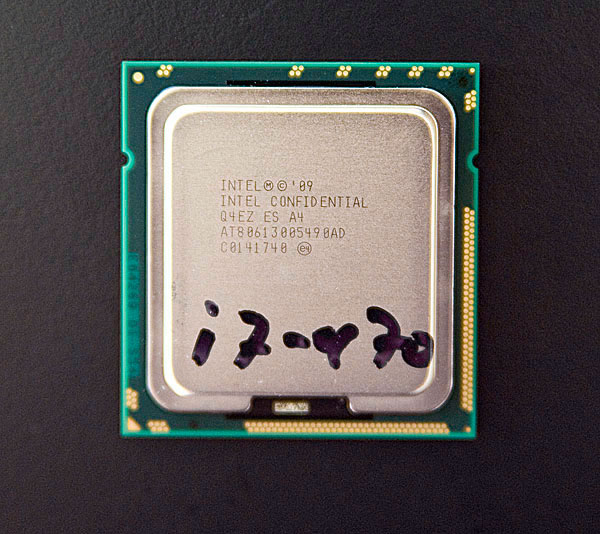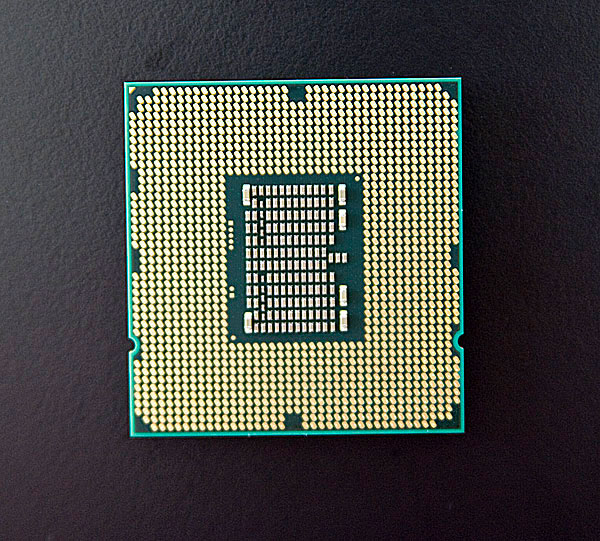Intel's Core i7 970 Reviewed, (Slightly) More Affordable 6-core
by Anand Lal Shimpi on July 29, 2010 3:23 AM EST
I ran into an old friend of mine who happens to work for Intel at an industry event last month. We were naturally talking about Intel when he pointed out that the company was doing very well. I agreed, but argued that Intel’s progress was being artificially limited by the fact that it wasn’t facing much competition at the high end.
It’s true. AMD’s entire desktop product line exists below $300, and we won’t see a real push for the high end crown until next year with Bulldozer. Until then, the real competition happens at lower (and arguably more interesting) price points where AMD gives you more cores for less, while Intel offers lower power consumption and better single threaded performance.
The ultra high end is still alive and well, despite the lack of competition in the market. Apple just announced its own dual-socket, 12-core monster that will begin shipping next month. Even Intel will tell you that it’s seeing more interest in the Core i7 980X than any previous Extreme Edition part. And the interest isn’t misplaced.
As the first 6-core desktop CPU based on Intel’s 32nm Gulftown core, the Core i7 980X was the first Extreme Edition in years to offer more than just a clock speed advantage. You got more cores, a larger L3 cache and virtually the highest clock speeds Intel has to offer. If you run highly threaded workloads, you can’t do any better on the desktop today. Thanks to its turbo modes, you don’t even give up performance in lightly threaded apps either.
The 980X of course carried an extreme price tag at $999. With more competition at the high end we might’ve seen derivative parts offered at lower clock speeds and lower price points. But until AMD delivers Bulldozer the impetus just isn’t there. Instead what we’re left with is a slow moving waterfall.
Early next year (Q1) Intel will introduce the Core i7 990X, a clock bumped version of the 980X. Presumably the 990X will run at 3.46GHz by default, but have the ability to turbo up even higher. The roadmap calls for another clock bump in Q2 depending on what AMD does.
Below the 980X there’s only a single 6-core desktop part for at least the next 6 months: the Core i7 970.

Its unassuming name implies little more than just a faster Core i7, however its $885 (1000 unit quantities) pricetag says otherwise. While the rest of the desktop Core i7 line is made up of 45nm quad-core Bloomfield and Lynnfield processors, the Core i7 970 is a 32nm 6-core Gulftown.
| Processor | Core Clock | Cores / Threads | L3 Cache | Max Turbo | TDP | Price |
| Intel Core i7 980X | 3.33GHz | 6 / 12 | 12MB | 3.60GHz | 130W | $999 |
| Intel Core i7 975 | 3.33GHz | 4 / 8 | 8MB | 3.60GHz | 130W | $999 |
| Intel Core i7 970 | 3.20GHz | 6 / 12 | 12MB | 3.46GHz | 130W | $885 |
| Intel Core i7 960 | 3.20GHz | 4 / 8 | 8MB | 3.46GHz | 130W | $562 |
| Intel Core i7 930 | 2.80GHz | 4 / 8 | 8MB | 3.06GHz | 130W | $284 |
| Intel Core i7 880 | 3.06GHz | 4 / 8 | 8MB | 3.73GHz | 95W | $583 |
| Intel Core i7 875K | 2.93GHz | 4 / 8 | 8MB | 3.60GHz | 95W | $342 |
| Intel Core i7 870 | 2.93GHz | 4 / 8 | 8MB | 3.60GHz | 95W | $294 |
| Intel Core i7 860 | 2.80GHz | 4 / 8 | 8MB | 3.46GHz | 95W | $284 |
| Intel Core i5 760 | 2.80GHz | 4 / 4 | 8MB | 3.33GHz | 95W | $205 |
| Intel Core i5 750 | 2.66GHz | 4 / 4 | 8MB | 3.20GHz | 95W | $196 |
| Intel Core i5 670 | 3.46GHz | 2 / 4 | 4MB | 3.73GHz | 73W | $284 |
| Intel Core i5 661 | 3.33GHz | 2 / 4 | 4MB | 3.60GHz | 87W | $196 |
| Intel Core i5 660 | 3.33GHz | 2 / 4 | 4MB | 3.60GHz | 73W | $196 |
| Intel Core i5 650 | 3.20GHz | 2 / 4 | 4MB | 3.46GHz | 73W | $176 |
| Intel Core i3 540 | 3.06GHz | 2 / 4 | 4MB | N/A | 73W | $133 |
| Intel Core i3 530 | 2.93GHz | 2 / 4 | 4MB | N/A | 73W | $113 |
| Intel Pentium G9650 | 2.80GHz | 2 / 2 | 3MB | N/A | 73W | $87 |
Like the 980X, the Core i7 970 has a 12MB L3 cache that’s shared by all six cores, all on a single 240mm2 die. The 1.17 billion transistor chip runs at a stock speed of 3.2GHz but can turbo up to 3.46GHz if two or fewer cores are active. With more than two active, and assuming no thermal or current limits are exceeded, the chip can run at 3.33GHz. For around $100 off the price of a 980X you’re not giving up much in terms of clock speed.
The uncore (everything outside of the CPU cores + L2 caches) also remains mostly unchanged. The 970 runs its uncore at 2.66GHz (identical to the 980X) but the QPI bus is stuck at 4.8GT/s vs. 6.4GT/s. The difference isn’t something that will appear in real world performance however.
| CPU | Codename | Manufacturing Process | Cores | Transistor Count | Die Size |
| Westmere 6C | Gulftown | 32nm | 6 | 1.17B | 240mm2 |
| Nehalem 4C | Bloomfield | 45nm | 4 | 731M | 263mm2 |
| Nehalem 4C | Lynnfield | 45nm | 4 | 774M | 296mm2 |
| Westmere 2C | Clarkdale | 32nm | 2 | 384M | 81mm2 |
| AMD Phenom II X6 | Thuban | 45nm | 6 | 904M | 346mm2 |
| AMD Phenom II X4 | Deneb | 45nm | 4 | 758M | 258mm2 |
Overall expect to see very close to 980X performance for $100 less. You lose the unlocked multiplier, which may have some overclocking implications, but that’s about it.
The rest of the Gulftown enhancements still apply. We finally get uncore power gating and AES-NI. The former gives us power consumption equal to 45nm quad-core Bloomfield i7s, while the latter improves encryption performance. Both of which we’ve demonstrated in the past.
BIOS Support and The Test
Any X58 motherboard with Gulftown support should work with the 970. As was the case with the original 980X launch, you’ll almost definitely need an updated BIOS to make this work.
Even Intel’s own DX58SO motherboard using the BIOS that originally enabled 980X support needed an update to work with the Core i7 970. Unfortunately you need to do this update before you install the CPU so make sure your board is up to date.

We’ve added the Core i7 970 results to Bench, our benchmark database. The graphs that follow are a subset of those results to keep the article reasonably sized.
| Motherboard: |
ASUS P7H57DV- EVO (Intel H57) Intel DP55KG (Intel P55) Intel DX58SO (Intel X58) Intel DX48BT2 (Intel X48) Gigabyte GA-MA790FX-UD5P (AMD 790FX) MSI 890FXA-GD70 (AMD 890FX) |
| Chipset Drivers: |
Intel 9.1.1.1015 (Intel) AMD Catalyst 8.12 |
| Hard Disk: | Intel X25-M SSD (80GB) |
| Memory: |
Corsair DDR3-1333 4 x 1GB (7-7-7-20) Corsair DDR3-1333 2 x 2GB (7-7-7-20) |
| Video Card: |
eVGA GeForce GTX 280 (Vista 64) ATI Radeon HD 5870 (Windows 7) |
| Video Drivers: |
ATI Catalyst 9.12 (Windows 7) NVIDIA ForceWare 180.43 (Vista64) NVIDIA ForceWare 178.24 (Vista32) |
| Desktop Resolution: | 1920 x 1200 |
| OS: |
Windows Vista Ultimate 32-bit (for SYSMark) Windows Vista Ultimate 64-bit Windows 7 x64 |











49 Comments
View All Comments
jlazzaro - Friday, July 30, 2010 - link
agreed with throwing older (920/930) OC'd procs in the mixPatrick Wolf - Thursday, July 29, 2010 - link
I don't understand why AT doesn't test games with max setings like with video cards. Doing so would be more helpful in seeing exactly what kind of CPU would actually be beneficial @ the settings most of us play at, or at least strive to play at.Etern205 - Thursday, July 29, 2010 - link
No it won't help you see which CPU will be beneficial because test a game at max setting will tax more on the GPU then the CPU.Also I don't see how games can show the advantage of these multicore cpus, photo imaging and encoding shows a clearer picture.
Patrick Wolf - Friday, July 30, 2010 - link
Yeah but these tests only help people using the same GPU and game settings. Testing at GPU limited settings would show what kind of CPU you'd need before performance is affected.I suppose these tests show which CPU has the most raw power and getting the best peformer would be more "future proof". But it you're looking to upgrade it doesn't show if it'd even be worth it. Both kinds of tests should be included really.
kallogan - Thursday, July 29, 2010 - link
I'm a cuda fan for 1080p video encoding. I'd never pay this price for a useless processor. My GTX 460 beat the shit out this i7 970 ;-) The only issue is that the Cuda x264 encoder in mediacoder allows only one pass for the moment...GPUs are our future !!!!
afkrotch - Thursday, July 29, 2010 - link
Imagine a 980X with two GTX 460s. Can always go more and more.ClagMaster - Thursday, July 29, 2010 - link
I could do better from a price/performance standpoint with the AMD 6-core processors than this i970.AMD Motherboards are cheaper and have much better connectivity. The price differential I could spend on better motherboards and more memory.
I run MCNP parallel jobs and the AMD processor just takes a little longer to complete the job.
stephenbrooks - Friday, July 30, 2010 - link
MCNP as in the neutron transport code for designing nuclear reactors?ClagMaster - Monday, August 2, 2010 - link
Yes. I do NJOY too.What is so ridiculous about the AMD and Intel Quad and Hex core products is they are more powerful than multi-million dollar Cray XMP and YMP computers I have used 20 years ago.
Mr Perfect - Thursday, July 29, 2010 - link
Looking at the Intel roadmap on page one is a little surprising. Are they honestly launching the new architecture in the mainstream and performance mainstream segments first? I was expecting them to launch the high-end chips first, like they did with Nehalem, and then trickle down the pricing ladder.If so, then great. We all won't have to wait another year for affordable Sandy Bridge systems.